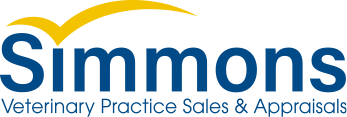By, David King, DVM, CVA, Simmons Southcentral
Like just about anything in life, deciding to sell a veterinary practice can be made easier with a little knowledge and a little planning. Knowing your options along with the pros and cons of each can help you make the right decision for you and your family’s future.
Reaching the Decision to Sell
Deciding to relinquish the reins of a practice is likely one of the biggest decisions most practitioners make in their professional lives and it does not come easily. Nevertheless, the time WILL come and good planning is important so that things are “ship shape” in the event of an unexpected exit. The goal of planning is to maintain both a practice and a facility that is attractive to buyers. Major consideration should be given to your emotional preparedness, as well. Take a close look in the mirror and see if you honestly are ready to separate yourself from the business that you so successfully built. Don’t exit until you are ready or you’ll be back. Do be prepared to exit unexpectedly, and your loved ones will appreciate your thoughtful planning. You never know when you will be required to exit.
The reasons most often given for leaving ownership are retirement (33%), career shift (43%) due to frustrations of management (hiring, supervising, government regulations, lawsuits, and bad debt clients), and personal (24%). Veterinarians often choose to leave ownership to enter specialty work, public or industrial practice, relief medicine, or business consulting (as I did when I sold my practice to begin veterinary practice appraisal and brokerage).
The decision process involves looking forward, both near term and long term. Are you mentally prepared to give up control? What do you plan to do next? Have you analyzed your financial situation adequately? The process often takes 1-2 years to complete, so planning far enough in advance is essential.
Practice Appraisal – Do It Early!
The days of “one year’s gross” are long gone. Today, practice value is based on its profitability, since that is what becomes available to pay any practice loan debt. The first step is to decide where you WANT to be, financially. Then, you need to find out where you are NOW, so you know what, if anything, needs to be done to get you from now to then. A practice valuation as a planning tool is invaluable as a starting point and really should be done every 3-5 years or even more frequently. It can be used as a planning tool to identify strong and weak areas in the practice.
What Are My Options?
Once the decision to make a change has been made, one must consider the specific plan. There are several options, depending on your goals. They are:
- Close the door and walk away. This actually happens too often, especially with practices that are rural, very small, have poor facilities and profit, and are out of date. This is not an issue with larger, multi-DVM practices.
- Maintain, develop, and improve. One choice is to “stay the course”, but making changes both to the facility and to the practice can be rejuvenating and can be a viable solution, especially if the timing for retirement is not quite right.
- Sell your interest to your partners. This is often a good solution IF they are interested. However, they are frequently in the same timeframe that you are, so it is most common for them not to be interested in owning more.
- Merge with other practices. This is gaining more popularity as 2 or 3 small practices join forces to maximize equipment, staff, and facility. Not only does this almost always improve profitability, but it also improves the quality of practice life. This again applies mostly to the smaller 1-2 DVM practices.
- Sell to a corporation. This is most viable for small animal practices since most of the corporate consolidators are not interested in mixed practice acquisitions. This is a niche that works well for some and not so well for others. Typically the selling price is good, but there is often a requirement that the owner stays on for two or more years. Some owners find it difficult to suddenly become an employee.
- Internal sale to an associate. With the right associate, this can be an excellent exit plan and is likely the most common option for multi-DVM practices. Both parties know each other, the risk to the seller is low, and the benefit to the buyer is high. These sales are often “seller-financed”.
- Sale to non-DVMs. This is often driven, at least in part, by state statute. Some states allow it and others don’t. However, even if not allowed, there are strategies that can be used to make this possible. As we know, there are many, many qualified entrepreneurs who have the desire, the ability, and the background to be superior owners of veterinary practices. If you believe you have such a potential buyer in mind, it is definitely worth your time to pursue it with your attorney.
- Sell on the open market. This remains the most common method of selling a small, one-DVM practice but is much less common for multi-DVM practices. Brokers can be of great assistance, not only in helping to locate the buyers, but, more importantly, in helping with contracts, financing, and the entire negotiating process.
- Do NOTHING. This is all too common. When an owner is really at the point he or she should move out, sometimes there is a long delay in making the decision, during which time the practice often deteriorates, loses revenue, and generally becomes hard to sell. It is always best to sell when the practice is healthy, growing, profitable, and up to date.
Associate Partial Buy-in
Some advisors recommend selling the practice to an associate in small increments. There are plusses and minuses to consider. It does allow the owner to maintain control and keep the current management philosophies in place. It is less “scary” to the buyer to buy in small increments. It allows the owner to continue to retain a larger share of the income. Finally, when an associate purchases, even 5 or 10% of the business, they are much more likely to remain at the practice. This is the “golden handcuff” theory.
There are also downsides to this type of sale. If the practice is properly priced, it should “buy itself”. In other words, whether a buyer buys 1% or 100%, the cost should not be an issue if the cash flow is sufficient to pay for the business, as it should be. The more of the business that is purchased, the more of the profits the buyer will receive with which to purchase all or part of the practice. Often, these profits represent more than the seller is receiving in a note payment (as it should be if the practice is appraised properly and the buyer expects a return on investment.) In this situation, the seller is not profiting as much as if he was the sole owner thus this might result in him “giving away” a portion of his practice. Many buyers are offended when only a minority share is offered. They say, “If you trust me and want me to be your partner, then let me be your FULL partner and not simply a partner in name only.” And, really, isn’t that the fairest approach to all? Finally, if a buyer purchases only a small percentage of the business and things do not work out, it will be a nightmare “undoing” that purchase unless there exists a very well-crafted and specific buy-sell provision in the partnership agreement.
100% Buy-out
Whether you are selling out to an associate or another private DVM on the open market, a buy-out is the cleanest and easiest way to exit. Money is readily available from third party lenders so often a seller can “cash out” and walk away from a practice soon after closing
Sell or Hold the Real Estate
Often owners are counseled to retain the real estate and lease it to the buyer of the practice. They are told that there are tax advantages, they will be able to receive rental income, and that there is less risk if they first sell the practice and then sell the real estate. Finally, they are told that the package will be more affordable without real estate. Let’s examine each of these.
Rental income
It is true that by retaining the property, rental income will be available. However, there are probably other, less specialized rental properties that would provide a better return than a veterinary hospital. The sellers could receive the same or more rental income from one of these.
Growing investment
Although the real estate is likely to increase in value, so would other properties in the same area. In fact, because a veterinary hospital is a special-use building, it is likely to appreciate slower than other, multi-use properties because the resale market is much smaller. Using a tax-deferred 1031 Exchange, the real estate can be sold along with the practice, and all of the taxes can be deferred if another investment property is purchased. Tax Code 1031 allows one to reinvest gains in real estate, tax-deferred, as long as there is no gain or loss in the transaction. Using tax-deferred procedures and reinvesting the capital gains tax, often 30% or more of the net proceeds, leaves the seller far ahead of one who simply chooses to sell and reinvest. The exchange procedure properly executed will not invite tax audits and is, in fact, a bona fide method for deferring taxes and is fully accepted by the IRS. A competent exchange intermediary can provide assistance and create an exchange throughout the U.S. without any additional effort on the part of the seller. A caveat here would include the recommendation that the seller would have to disclose their intent to carry out a 1031 Exchange in all listing and other documents leading up to and including the closing. While this strategy is not widely known, any accountant or tax attorney should be able to obtain the rules and locate a qualified exchange intermediary. It is an extremely useful tool, one that should be seriously considered when attempting to maximize their valuable real estate investment resource.
Sell practice first
There is a misconception that if the seller retains the real estate during the sale of the practice and the buyer defaults, the real estate can be easily resold. That may or may not be true. Again, this is a special-use building and likely would have its very best value as a veterinary hospital. In this situation, reselling might require the seller to go back in and rejuvenate a practice that has been run down. The reality is that DVMs are very low-risk buyers. In fact, the SBA has named veterinarians the best profession for NOT defaulting on SBA loans, an admirable “feather” for our profession.
Too much cost
Owners often think that if they do not sell the real estate, it will make the purchase more affordable. In actuality, this is untrue in today’s aggressive lending market. The buyer will need to pay either rent or a mortgage and today, for the same piece of property, the mortgage payments are usually less than rent payments would be. With aggressive lending for the practices, it is not uncommon for a buyer to be able to purchase both and practice and real estate with little or no down payment.
Finally, buyers almost always want to purchase both practice and real estate (you did, didn’t you?). If the seller is able to offer that as an option, it expands the market of interested buyers considerably.
Corporate buyers
It seems like almost every day a new group is moving into the veterinary corporate consolidator space. Everyone knows the “big dogs” like VCA and NVA but there are many other names as well. So many, in fact, that one almost needs a program to keep them all straight. With more and more consolidators in the market, the individual practice owner is getting courted to sell his/her practice at a rate that is spiraling upward. So now it is not bad enough that an owner is busy trying to do good medicine and run a practice but now has to deal with all the attention from consolidators.
All corporate consolidators (CC) are not the same and thus no single practice would be desired by every one of them. One CC may be interested in practices with $1.0M+ in gross revenues, another may be wanting a certain number of DVMs, while another may only be interested in specialty practices. Also, several CCs are regionally limited and thus will only consider practices in their particular market.
There are three things that just about every CC is looking for in a practice – High gross revenue, profitability, and location. If your practice has all three then you will be a strong corporate target. However, if you have two of the three then often corporations will still be interested. CC will also offer an all-cash deal, often at a premium price. However, for this premium price, they will ask for such things as employment after the sale, a large non-compete area, and non-competes with all associates.
Selling to corporate consolidators can be an excellent way for some owners to get their equity out now, with the ability to still work as a DVM for a few more years after the sale.
Knowing your options when it comes to selling your practice is a must. It will allow you to plan. The more you know the better you will plan, the better you plan the better the exit experience will be. Simmons exists to help you form the best plan for you and the best plan for your practice. Contact your regional expert to start planning.



